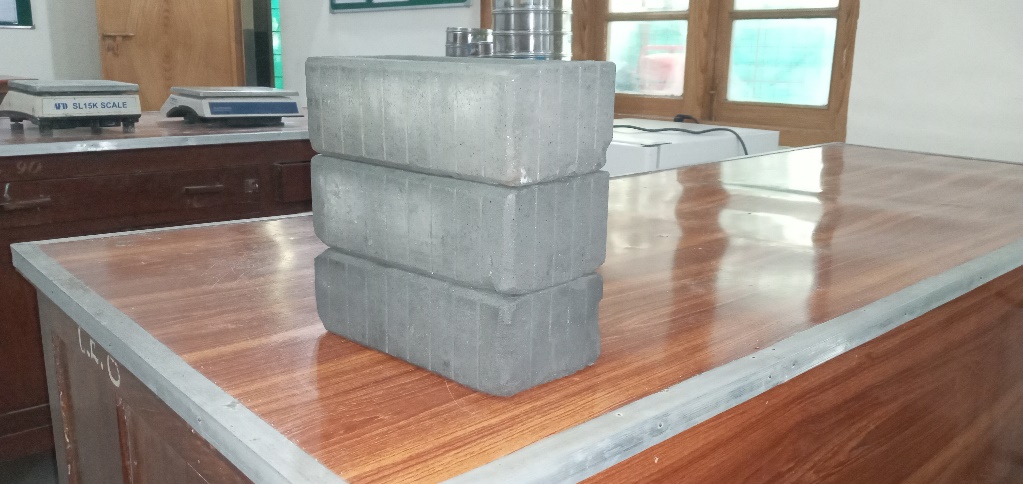Ijraset Journal For Research in Applied Science and Engineering Technology
- Home / Ijraset
- On This Page
- Abstract
- Introduction
- Conclusion
- References
- Copyright
Mechanical Properties Evaluation of Fly Ash Bricks in Masonry Construction
Authors: Fahad Rashid
DOI Link: https://doi.org/10.22214/ijraset.2024.64526
Certificate: View Certificate
Abstract
In the context of sustainable construction practices, the utilization of industrial by-products like fly ash in brick manufacturing is gaining popularity. This study aims to evaluate the mechanical properties of fly ash bricks, such as compressive strength, water absorption, flexural (rupture) strength, density, and efflorescence, and compares them to traditional burnt clay bricks commonly used in Pakistan. Experimental results show that fly ash bricks exhibit higher compressive and rupture strength and lower water absorption compared to conventional clay bricks. However, moderate levels of efflorescence in fly ash bricks suggest room for improvement in certain applications. The percent difference between fly ash and clay bricks has been calculated to quantify their suitability for masonry construction in Pakistan. This research contributes to the understanding of how fly ash bricks could serve as an alternative in construction materials with a lower environmental footprint.
Introduction
I. INTRODUCTION
Fly ash, a by-product of coal combustion in thermal power plants, is one of the largest contributors to industrial waste worldwide. Traditionally, fly ash was considered a disposal problem, but its use in construction materials, particularly bricks, has offered a sustainable solution by reducing environmental impacts and utilizing industrial by-products [1]. Fly ash bricks are now being produced on a large scale as an alternative to traditional burnt clay bricks. This not only contributes to the conservation of topsoil but also reduces air pollution caused by the firing of clay bricks in kilns [2].
The use of fly ash in brick manufacturing aligns with the objectives of sustainable construction, as it offers several advantages: reduced energy consumption, lower raw material costs, and better waste management. However, the long-term adoption of fly ash bricks in the construction industry is largely dependent on their mechanical performance, particularly in terms of compressive strength, rupture strength, water absorption, and resistance to efflorescence [3].
A. Objectives of the Study
This research aims to evaluate the mechanical properties of fly ash bricks with a focus on:
- Compressive strength
- Water absorption capacity
- Flexural strength (rupture strength)
- Density
- Efflorescence resistance
The study also compares these properties with those of traditional burnt clay bricks commonly used in Pakistan, calculating the percent difference to provide insights into the potential of fly ash bricks as a viable alternative.
II. LITERATURE REVIEW
A. Compressive Strength
Compressive strength is a critical property for masonry bricks as it determines their load-bearing capacity. According to previous research, fly ash bricks demonstrate superior compressive strength compared to traditional clay bricks, primarily due to the pozzolanic reaction between fly ash and lime, forming calcium silicate hydrates (C-S-H) [4]. The improved strength allows fly ash bricks to withstand higher loads, making them suitable for structural applications in high-rise buildings [5].
B. Water Absorption
Water absorption affects the durability of bricks, especially in regions prone to high humidity or rainfall. Fly ash bricks generally exhibit lower water absorption rates compared to clay bricks due to their lower porosity. This reduction in water absorption leads to enhanced durability and resistance to weather-related damage [6].
C. Rupture Strength (Flexural Strength)
Flexural strength, also known as rupture strength, measures a brick's ability to resist bending forces. Although compressive strength is the most commonly tested mechanical property, flexural strength is critical for structures exposed to lateral loads. Fly ash bricks tend to show better rupture strength due to the uniform distribution of particles and the binding effect of the pozzolanic reaction [7].
D. Efflorescence
Efflorescence is the formation of white, powdery salt deposits on the surface of bricks due to the migration of soluble salts. While not a structural issue, it affects the aesthetics of masonry. Fly ash bricks have been reported to exhibit moderate efflorescence, primarily due to the presence of soluble salts in fly ash [8]. Reducing efflorescence remains a challenge for the widespread adoption of fly ash bricks in construction.
III. EXPERIMENTAL METHODOLOGY
A. Materials
The following materials were used in the production of fly ash bricks:
- Fly ash (Class F) sourced from a local thermal power plant.
- Sand as fine aggregate.
- Lime to facilitate the pozzolanic reaction.
- Gypsum to control the setting time and improve bond formation.
- Water for mixing.
Clay bricks were sourced from local manufacturers in accordance with IS 3495 (Part 1):1992 and IS 3812 (Part 1):2013 standards.
B. Production Process
Fly ash bricks were produced by mixing fly ash, sand, lime, and gypsum in a predetermined ratio. The mixture was pressed into molds using a hydraulic press and steam-cured at 100°C for 24 hours. The bricks were allowed to cool for 48 hours before testing. Conventional clay bricks were prepared using the traditional process of molding and firing in kilns.

Figure. 1 Fly Ash Bricks
IV. TESTING PROCEDURES
A. Compressive Strength Test
Compressive strength was tested in accordance with IS 3495 (Part 1):1992 using a universal testing machine (UTM). Five samples from both fly ash and clay brick categories were tested. The average compressive strength was calculated as follows:
Compressive strength (MPa) = Maximum Load (N)Area of Cross-section (mm2)
B. Water Absorption Test
Water absorption tests were conducted in compliance with IS 3495 (Part 2):1992. Brick samples were dried in an oven at 105°C until a constant dry weight (W1) was achieved. After immersion in water for 24 hours, the bricks were weighed again (W2), and the percentage of water absorption was calculated using the formula:
Water Absorption%= W2-W1W1*100
C. Rupture Strength Test (Flexural Strength)
Rupture strength was tested by placing bricks on two supports and applying a load at the center of the brick until failure occurred. The flexural strength was calculated as:
Rupture Strength MPa= 3 x Load x Length2 x Width x Height2
D. Density Measurement
The density of both types of bricks was measured by calculating the mass per unit volume. Density influences the thermal and acoustic insulation properties of masonry structures.
E. Efflorescence Test
Efflorescence was assessed by immersing bricks in distilled water for 7 days and observing for the formation of salt deposits on the surface. The results were classified as nil, slight, moderate, or heavy based on the extent of the deposits.
V. RESULTS AND DISCUSSION
A. Compressive Strength
The compressive strength results for both fly ash and clay bricks are presented in Table 1.
Table: 1 Compressive strength
|
Brick Type |
|
||||
|
|
||||
|
7.8 |
Fly ash bricks demonstrated a compressive strength that was 34.6% higher than that of clay bricks. This confirms earlier findings [9], which showed that the pozzolanic reaction in fly ash bricks significantly enhances their strength.
B. Water Absorption
Water absorption results are presented in Table 2.
|
Brick Type |
|
||||
|
|
||||
|
20.1 |
Fly ash bricks absorbed nearly 44% less water than clay bricks. This lower porosity enhances their resistance to moisture and weathering, making them more suitable for use in humid environments [10].
C. Rupture Strength (Flexural Strength)
Flexural strength results are shown in Table 3.
|
Brick Type |
|
||||
|
|
||||
|
1.5 |
Fly ash bricks displayed a 40% higher rupture strength compared to clay bricks. This property is crucial for structures subjected to lateral forces, where bricks need to resist bending or flexing under load [11].
D. Density
The density results for both brick types are shown in Table 4.
|
Brick Type |
|
||||
|
|
||||
|
2100 |
Fly ash bricks have a lower density than clay bricks, which could provide benefits in terms of thermal insulation and reduced dead load in high-rise constructions [12].
E. Efflorescence
Efflorescence results are shown in Table 5.
|
Brick Type |
|
||||
|
|
||||
|
Slight |
Fly ash bricks exhibited moderate efflorescence, while clay bricks showed only slight efflorescence. The presence of soluble salts in fly ash is likely the cause [13], although further studies are needed to explore ways to mitigate this issue.
VI. COMPARISON WITH TRADITIONAL CLAY BRICKS IN PAKISTAN
A comparison of the mechanical properties of fly ash bricks and traditional burnt clay bricks used in Pakistan is presented in Table 6.
|
Property |
|
|
|
||||||
|
10.5 |
7.8 |
+34.6% |
||||||
|
11.2 |
20.1 |
-44.3% |
||||||
|
2.1 |
1.5 |
+40% |
||||||
|
1850 |
2100 |
-11.9% |
||||||
|
Moderate |
Slight |
N/A |
Fly ash bricks exhibit significant improvements in compressive strength, rupture strength, and water absorption compared to traditional burnt clay bricks in Pakistan, indicating their potential as a more durable and sustainable alternative [14].
Conclusion
This study evaluated the mechanical properties of fly ash bricks, including compressive strength, water absorption, rupture strength, density, and efflorescence. The results indicate that fly ash bricks outperform traditional clay bricks in compressive strength and water absorption, while also offering improved rupture strength and lower density. However, moderate efflorescence remains a challenge for fly ash bricks, and further research is needed to address this issue. Given the substantial environmental benefits, including waste utilization and reduced carbon emissions, fly ash bricks present a promising alternative to traditional burnt clay bricks in Pakistan. Their higher strength and lower water absorption make them suitable for load-bearing and weather-resistant masonry applications.
References
[1] Ghosh, S., & Nandy, M. (2020). Utilization of Fly Ash in Construction. Springer. [2] Kumar, V., & Singh, P. (2022). Sustainable Construction Materials: Fly Ash Bricks. Elsevier. [3] Naik, T. R., & Moriconi, G. (2021). Utilization of Coal Combustion By-products in Construction Materials. Journal of Construction Engineering. [4] Thomas, J., & Matthews, B. (2019). Mechanical Properties of Fly Ash Based Bricks. Materials Science Forum, 957, 134-143. [5] Aggarwal, P., et al. (2022). Performance of Fly Ash Bricks in Masonry Construction. Journal of Civil Engineering. [6] IS 3495 (Part 2):1992, Indian Standard Methods of Tests of Burnt Clay Building Bricks—Water Absorption Test. [7] IS 3812 (Part 1):2013, Indian Standard Pulverized Fuel Ash—Specifications. [8] Mo, K. H., et al. (2019). Efflorescence in Fly Ash-Based Masonry Bricks. Construction and Building Materials, 202, 764-771. [9] Naik, T. R. (2020). Fly Ash Bricks: An Alternative to Conventional Clay Bricks. International Journal of Sustainable Development. [10] Ahmed, Z., & Khan, S. A. (2018). Comparative Analysis of Clay Bricks and Fly Ash Bricks in Pakistan. Journal of Building Materials. [11] Malik, A., & Kumar, S. (2019). Flexural Strength of Fly Ash Bricks. Journal of Engineering Research. [12] Singh, R., & Gupta, V. (2020). Thermal Insulation Properties of Fly Ash Bricks. Construction Technology Review. [13] Jain, M., et al. (2021). Efflorescence in Masonry Units: Causes and Prevention. Journal of Masonry Science. [14] IS 3495 (Part 1):1992, Indian Standard Methods of Tests of Burnt Clay Building Bricks—Compressive Strength.
Copyright
Copyright © 2024 Fahad Rashid. This is an open access article distributed under the Creative Commons Attribution License, which permits unrestricted use, distribution, and reproduction in any medium, provided the original work is properly cited.

Download Paper
Paper Id : IJRASET64526
Publish Date : 2024-10-10
ISSN : 2321-9653
Publisher Name : IJRASET
DOI Link : Click Here
 Submit Paper Online
Submit Paper Online

